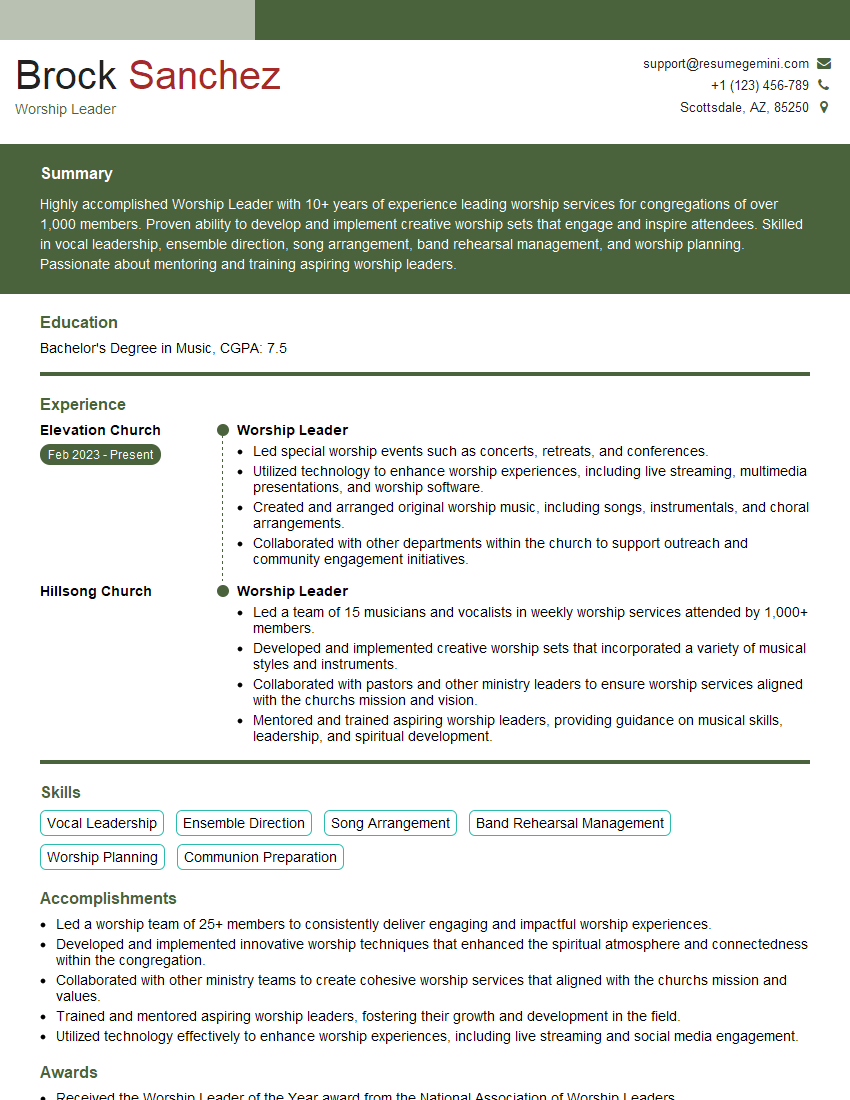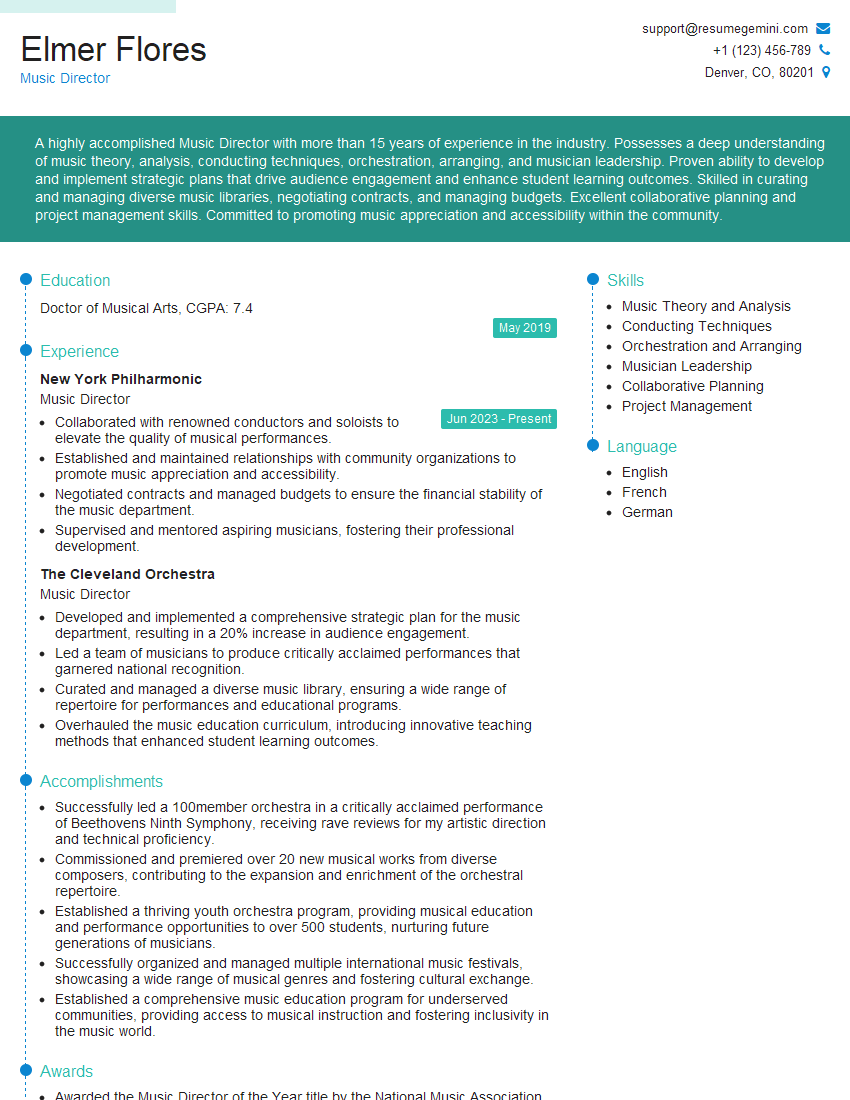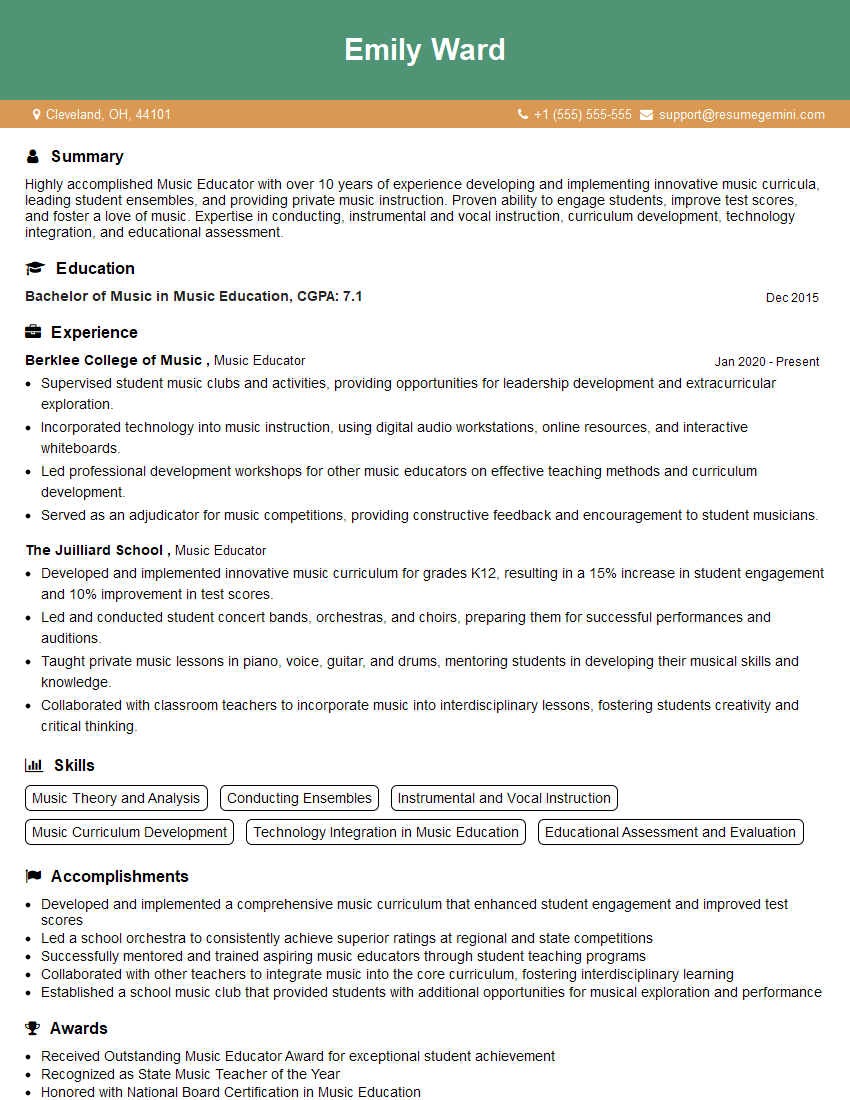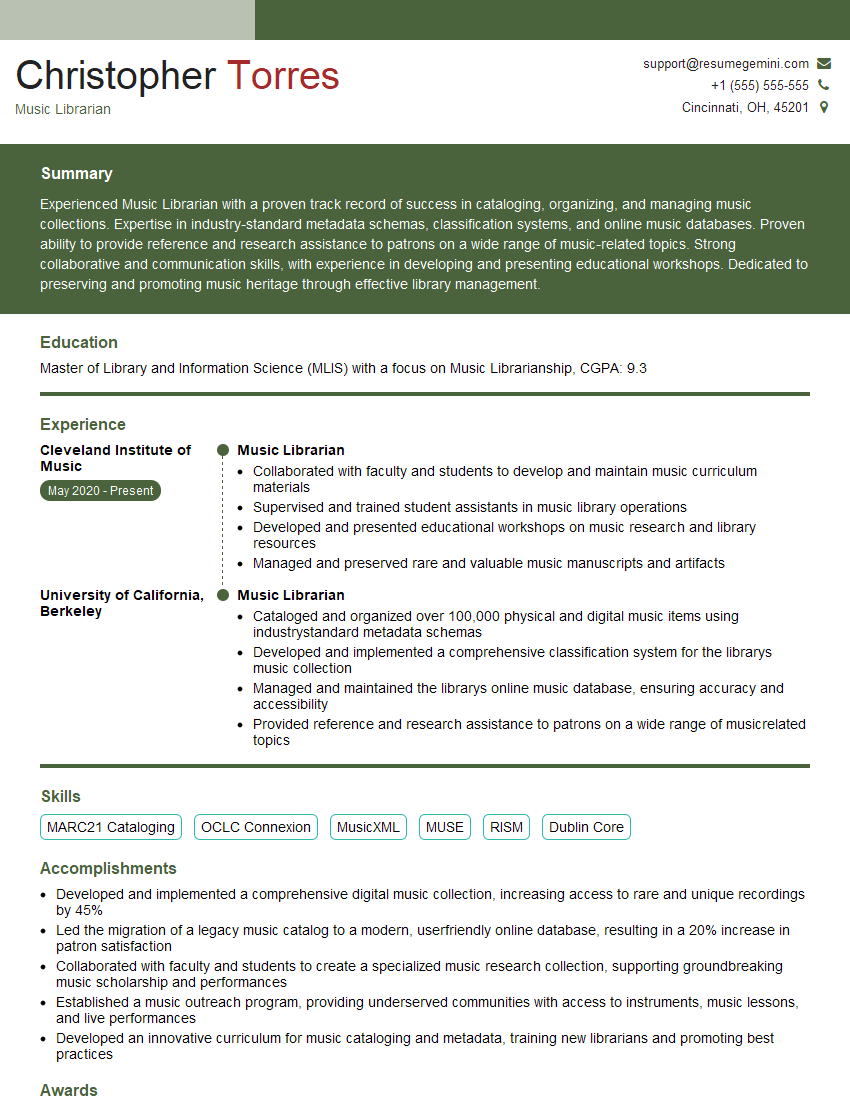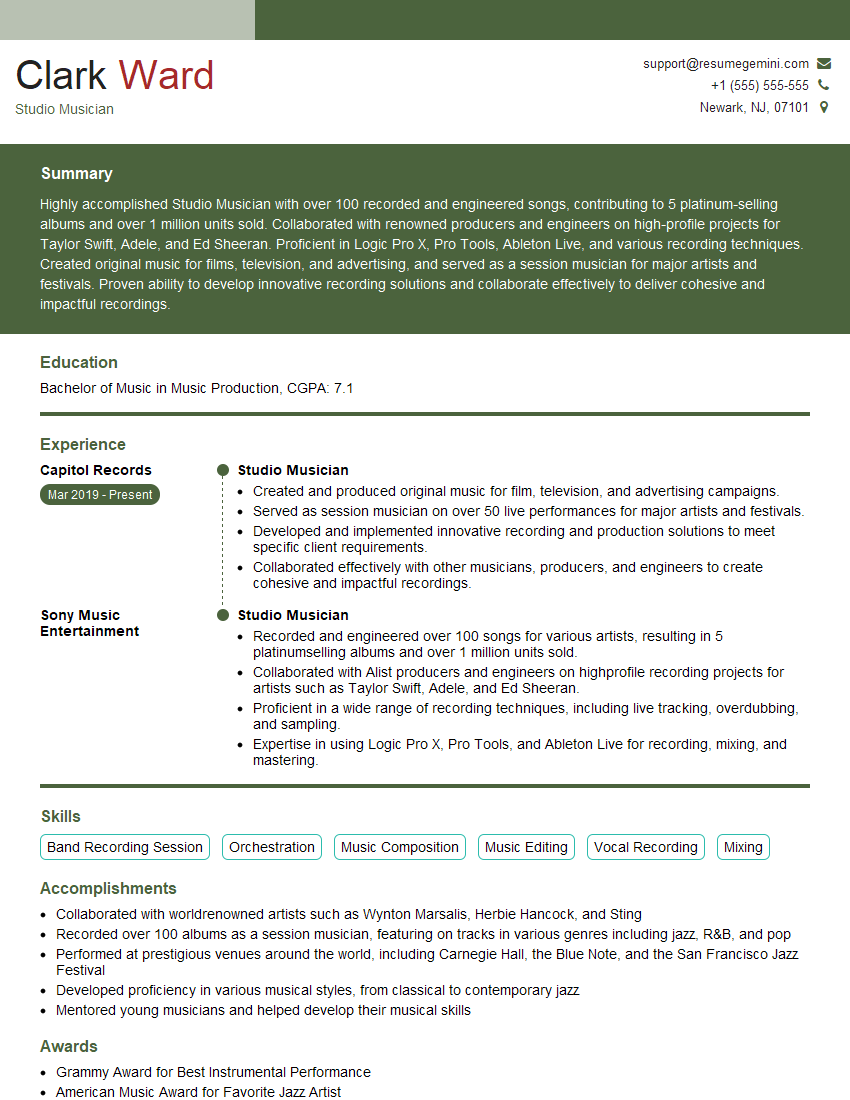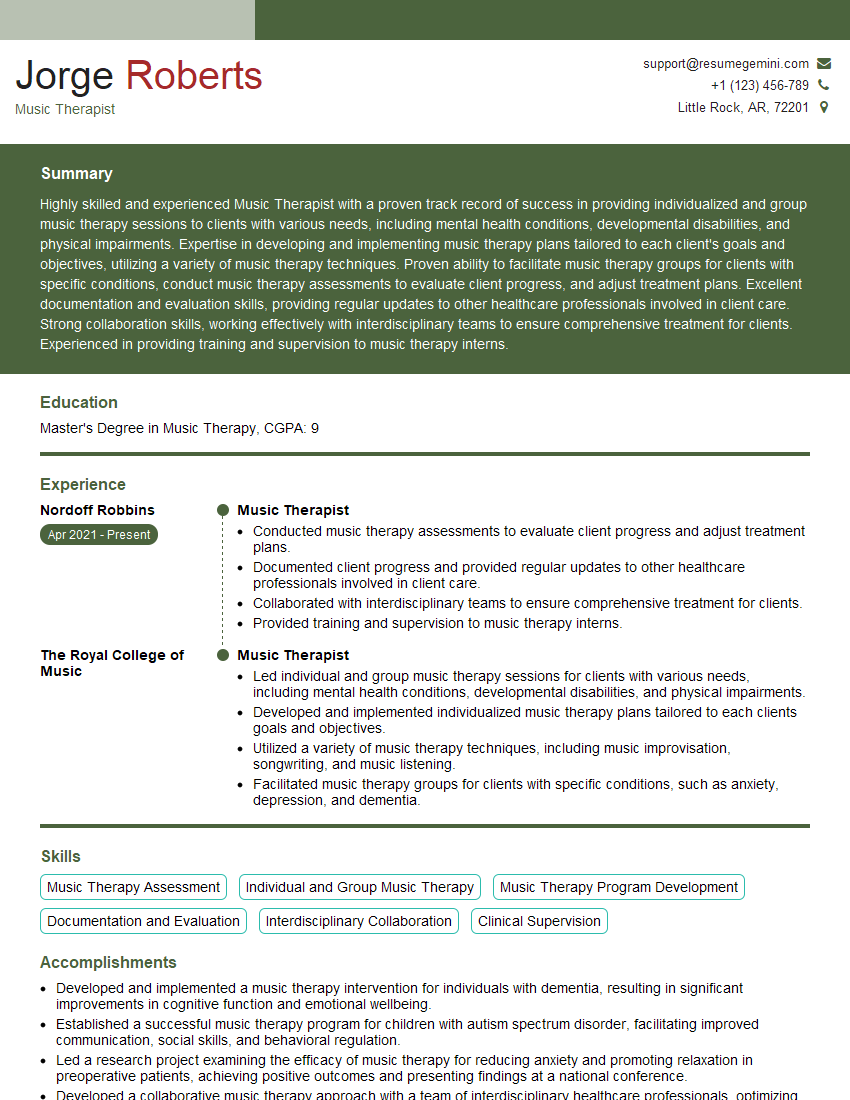Unlock your full potential by mastering the most common Experience in playing multiple instruments interview questions. This blog offers a deep dive into the critical topics, ensuring you’re not only prepared to answer but to excel. With these insights, you’ll approach your interview with clarity and confidence.
Questions Asked in Experience in playing multiple instruments Interview
Q 1. Describe your experience playing different instruments.
My musical journey has been a fascinating exploration across various instrument families. I started with the piano at age seven, developing a strong foundation in music theory and reading notation. This foundational understanding significantly aided my subsequent exploration of other instruments. Later, I picked up the violin, drawn to its expressive capabilities, followed by the guitar, captivated by its versatility across genres. More recently, I’ve been delving into the world of percussion, specifically the drums, appreciating the rhythmic complexity and physicality involved. Each instrument presented unique challenges and rewards, enriching my overall musical understanding.
Q 2. What instruments are you proficient in, and what is your level of proficiency in each?
I consider myself proficient in piano (advanced), violin (intermediate-advanced), guitar (intermediate), and drums (intermediate). My piano proficiency stems from years of dedicated practice and formal training, including participation in competitions and recitals. My violin skills are strong, encompassing both classical and some folk styles. My guitar skills are versatile, comfortable with both fingerstyle and strumming techniques across diverse genres. With the drums, I’m focused on developing a solid rhythmic foundation and exploring various drumming styles.
Q 3. How do you adapt your playing style to different instruments?
Adapting my playing style to different instruments involves understanding the unique characteristics of each. For instance, the piano’s polyphonic nature requires a different approach than the violin’s monophonic expression. With the piano, I prioritize articulation and voicing; on the violin, I focus on bowing techniques and vibrato. The guitar demands finger dexterity and a focus on rhythmic phrasing, while drums require physical coordination and a deep understanding of time signatures and groove. It’s like learning a new language for each instrument – the grammar and vocabulary are different, but the underlying musical principles remain consistent.
Q 4. Explain your approach to learning a new instrument.
My approach to learning a new instrument is systematic and multi-faceted. I begin with the fundamentals – understanding the instrument’s mechanics, basic techniques, and notation (if applicable). I then build a foundation through structured lessons or self-study using reputable resources. I emphasize consistent practice, focusing on incremental progress and avoiding overwhelming myself. I also incorporate elements of active listening, analyzing the playing of master musicians on the chosen instrument to internalize nuances of style and technique. Regularly assessing my progress helps to identify areas needing improvement and adjust my practice accordingly.
Q 5. Describe a challenging musical piece you’ve mastered on multiple instruments.
Mastering Bach’s Chaconne from Partita No. 2 for solo violin has been a significant challenge across multiple instruments. On the violin, the technical demands are immense, requiring precision bowing, flawless intonation, and expressive phrasing. Adapting this piece to the piano involved re-harmonizing and re-imagining the melodic lines, demanding a deep understanding of counterpoint and voicing. I even attempted a transcription for guitar, which presented a unique set of challenges related to the instrument’s range and capabilities. Each rendition required a complete rethinking of the piece, highlighting the versatility and adaptability demanded by multi-instrumental performance.
Q 6. How do you manage your practice time across multiple instruments?
Managing practice time across multiple instruments requires careful planning and prioritization. I allocate specific time slots for each instrument, ensuring a balanced approach. Some days might be dedicated to a particular instrument based on upcoming performances or projects, while other days are reserved for foundational work. I employ a cyclical approach, ensuring that I revisit each instrument regularly to avoid stagnation and maintain proficiency. It’s a juggling act, but a well-structured schedule is essential for maintaining momentum and preventing burnout. Flexibility is key; I adjust my schedule based on my energy levels and the demands of different projects.
Q 7. What are your strengths and weaknesses as a multi-instrumentalist?
My strengths as a multi-instrumentalist include a strong foundation in music theory, versatility in musical styles, and the ability to quickly grasp new technical concepts. I’m also adept at adapting arrangements across different instruments. However, my weakness is the potential for spreading myself too thin. Maintaining proficiency across multiple instruments requires consistent and dedicated effort. This necessitates careful time management and prioritization to avoid sacrificing progress on any one instrument. I actively work to balance my practice to avoid this pitfall.
Q 8. Discuss your experience performing in various musical settings.
My performance experience spans a wide range of musical settings, from intimate solo recitals to large-scale orchestral performances and everything in between. I’ve played in jazz combos, chamber ensembles, rock bands, and even musical theater productions. Each setting demands a unique approach. For instance, a solo recital requires intense focus on individual expression and nuanced dynamics, while orchestral work necessitates precise timing and responsiveness to the conductor and other musicians. In jazz combos, improvisation and spontaneous communication are paramount. The experience of adapting to these diverse contexts has honed my adaptability and performance skills considerably.
- Solo Recital Example: My performance of Bach’s Cello Suites demanded meticulous attention to detail, phrasing, and articulation, focusing on conveying the composer’s emotional intent.
- Orchestral Example: Playing in a Mahler symphony required precise adherence to the conductor’s cues, blending my sound seamlessly with the ensemble, and maintaining stamina throughout a lengthy performance.
- Jazz Combo Example: Improvising on a bebop standard involved listening intently to my bandmates, responding spontaneously to their musical ideas, and maintaining a strong rhythmic foundation.
Q 9. Describe your experience with music theory and its application to multiple instruments.
Music theory is the bedrock of my musicianship, informing my approach to all instruments. My understanding extends beyond basic harmony and rhythm; it encompasses counterpoint, orchestration, form, and analysis. This knowledge allows me to understand the underlying structure of any piece of music, regardless of the instrument. For example, I can analyze a piano sonata’s harmonic progression and apply that same understanding to arranging the piece for a string quartet, adapting the voicing and texture to suit the different timbres.
Applying theory to multiple instruments involves understanding the unique technical limitations and expressive possibilities of each instrument. A melody that works beautifully on the violin might require significant adaptation for the cello, considering its lower register and different bowing techniques. The theoretical framework provides the structure, while practical knowledge dictates how to best express that structure on each specific instrument.
Q 10. How do you approach sight-reading on different instruments?
Sight-reading is a crucial skill, and my approach differs slightly depending on the instrument. The key is to efficiently process the information on the page and translate it into sound. With instruments like the piano, I focus on quickly identifying chord structures and melodic patterns. With string instruments, I prioritize bowing techniques and finger placement. Wind instruments require attention to breath support and embouchure. I generally start by scanning the piece for key signatures, time signatures, and overall structure before diving into the details. I try to anticipate rhythmic and melodic patterns, and I’m not afraid to make minor mistakes initially – it’s about building fluency over perfection in the first pass.
Regular practice is essential. I dedicate time to sight-reading exercises across all my instruments, gradually increasing the difficulty level. This approach has made me proficient at quickly interpreting new musical material, regardless of the instrument.
Q 11. Explain your understanding of music notation across various instrument families.
My understanding of music notation encompasses the conventions used across various instrument families. While the basic elements – notes, rests, clefs, and time signatures – remain constant, the specific notation can vary dramatically depending on the instrument. For instance, a bass clef is commonly used for bass instruments, while treble clef is typical for higher-pitched instruments. Percussion instruments often use specialized notation indicating the specific type of instrument and playing technique. Understanding these nuances is vital for accurate performance.
The placement of notes on the staff represents pitch, but the interpretation of those pitches changes based on the instrument’s range and capabilities. A note on the staff might represent a low C on the cello but a high C on the violin. Further, the notation may indicate specific techniques, such as bowing styles for strings or tonguing techniques for winds. My experience allows me to instantly recognize and interpret these details for a wide range of instruments.
Q 12. Describe your experience with improvisation across different instruments.
Improvisation is a cornerstone of my musical expression, and my approach varies based on the instrument and musical context. On the piano, improvisation often involves exploring complex chord progressions and intricate melodic lines. On the saxophone, I rely more on phrasing and blues scales, creating soulful melodies. The process often begins with a harmonic foundation, which I use as a springboard for melodic ideas. I also incorporate rhythmic variations, exploring syncopation and polyrhythms to add complexity.
Improvising across multiple instruments requires an understanding of the individual instruments’ expressive capabilities and limitations. A melodic idea that sounds effortless on the piano might require adjustments when played on a clarinet, for instance. The key lies in being musically resourceful, adapting your ideas to suit the instrument’s unique voice and ensuring that the improvisation still serves the overall musical context.
Q 13. How do you handle the technical challenges of playing multiple instruments?
Playing multiple instruments presents technical challenges, but effective practice strategies can mitigate them. I focus on developing a strong foundation in basic techniques for each instrument. This includes proper posture, hand position, embouchure (for wind instruments), and bowing technique (for strings). Consistency in practice is crucial; even short, focused sessions are more effective than infrequent, lengthy ones. I often incorporate cross-training, practicing exercises that develop transferable skills, such as finger dexterity or breath control.
Furthermore, I adapt exercises to address specific challenges. If I’m struggling with a particularly difficult passage on the violin, I might break it down into smaller sections, practicing them slowly and gradually increasing the speed. Seeking guidance from experienced teachers for each instrument also helps avoid developing bad habits and ensures efficient technique development.
Q 14. How do you ensure consistent tone and quality across different instruments?
Maintaining consistent tone and quality across different instruments requires careful attention to detail and regular practice. For wind instruments, this involves maintaining consistent embouchure and breath control. With string instruments, it’s about achieving a consistent bow stroke and finger pressure. On keyboard instruments, it’s about evenness of touch and articulation. Regular maintenance of the instruments themselves – cleaning, tuning, and proper storage – is vital. I regularly record myself playing each instrument to objectively assess my tone and identify areas for improvement.
Furthermore, I actively seek feedback from teachers and other musicians to ensure my tone quality meets professional standards. Listening to recordings of master musicians helps me understand ideal tone production and refine my own technique accordingly. A consistent approach to practice, regular maintenance, and critical self-assessment are all crucial for producing a high-quality sound across different instruments.
Q 15. Describe your experience with recording music on multiple instruments.
Recording myself on multiple instruments is a multifaceted process requiring meticulous planning and execution. It starts with a clear vision for the final product – knowing the desired sound and arrangement is paramount. For example, if I’m recording a song with vocals, acoustic guitar, and piano, I’ll typically record the acoustic guitar first as it forms the rhythmic backbone. This allows me to build the other instruments around it. Then, I’d layer the piano, focusing on creating harmonic depth and texture, careful to avoid clashing with the guitar. Finally, I’d record the vocals, ensuring they sit well in the mix. I use digital audio workstations (DAWs) like Logic Pro X or Ableton Live, which provide tools for editing, mixing, and mastering. The key is to track each instrument individually, ensuring proper levels and minimizing bleed (unwanted sound from other instruments). This allows for flexibility during mixing, enabling me to adjust each instrument’s volume and EQ to achieve the ideal balance. Each instrument needs to be recorded with suitable microphones, and I’ll often use multiple microphone techniques – like close miking for a detailed sound and room miking for a more spacious feel – to capture the nuances of each instrument. Post-recording, mastering is critical for optimizing the overall sound across different playback systems. This involves equalization, compression, and sometimes adding reverb or delay to enhance the ambience.
Career Expert Tips:
- Ace those interviews! Prepare effectively by reviewing the Top 50 Most Common Interview Questions on ResumeGemini.
- Navigate your job search with confidence! Explore a wide range of Career Tips on ResumeGemini. Learn about common challenges and recommendations to overcome them.
- Craft the perfect resume! Master the Art of Resume Writing with ResumeGemini’s guide. Showcase your unique qualifications and achievements effectively.
- Don’t miss out on holiday savings! Build your dream resume with ResumeGemini’s ATS optimized templates.
Q 16. How do you approach ensemble playing with multiple instruments?
Ensemble playing requires a high degree of listening, communication, and musicality. When playing with others, I prioritize active listening to ensure my part complements the others. This involves paying close attention to both rhythm and harmony. For example, if I’m playing the cello in a string quartet, I’ll be acutely aware of the violin’s melodic line and the viola’s harmony to support the overall texture. Beyond listening, effective communication is vital. Before rehearsals or performances, we’ll often discuss the piece’s dynamics, phrasing, and articulation to achieve a cohesive sound. During rehearsals, I’ll be open to feedback from other musicians and willing to adapt my playing to better integrate with the ensemble. I also find it beneficial to visually cue from the conductor or lead musician to maintain tempo and ensure a unified performance. In my experience, a good ensemble is built on mutual respect and trust, and that trust allows for a natural sense of give-and-take during the performance itself.
Q 17. How do you maintain your skills and continue learning on multiple instruments?
Maintaining skills and continuing to learn on multiple instruments is an ongoing process. I approach it with a structured yet flexible plan. Firstly, consistent practice is essential. I allocate specific times each week for each instrument, adapting the schedule depending on upcoming performances or projects. I often break down my practice sessions into focused segments, targeting specific areas such as technique, sight-reading, and musicality. For example, on the piano I might spend time on scales and arpeggios to improve dexterity and then focus on a specific piece to improve expression and interpretation. To avoid plateauing, I constantly seek out new challenges – learning new pieces, exploring different musical styles, and experimenting with new techniques. I also believe in incorporating diverse learning methods; for example, I’ll attend workshops, take masterclasses, and actively listen to and analyze the performances of other musicians. This helps me refine my skills and expand my musical horizons. Finally, I find it crucial to record my practice sessions or performances to identify areas for improvement and monitor my progress over time. This self-assessment is essential for continuous growth.
Q 18. Describe your experience working with different musical genres.
My experience spans a wide range of genres, including classical, jazz, pop, and folk. This diversity has significantly shaped my musical approach. Playing classical music has instilled discipline, precision, and a deep understanding of musical theory. Jazz has nurtured my improvisational skills, harmonic awareness, and rhythmic flexibility. Pop music has expanded my understanding of arranging, songwriting, and production techniques. Lastly, folk music has provided exposure to diverse rhythmic patterns and unique instrumental styles. For instance, working on a classical sonata requires focused attention to detail and accurate execution, whilst a jazz solo demands spontaneity and creativity. Each genre demands a different approach to phrasing, dynamics, and articulation. I adapt my techniques and approach to match the specifics of each genre. This versatility has proven invaluable in various collaborative projects, allowing me to seamlessly transition between styles and approaches based on the context.
Q 19. How do you handle feedback on your playing across multiple instruments?
Handling feedback on my playing across multiple instruments requires a mature and open-minded approach. I actively seek feedback from trusted teachers, mentors, and fellow musicians. I listen attentively and carefully consider the criticism without taking it personally. When receiving feedback, I try to understand the context of the criticism – what specific aspect of my playing needs improvement. I ask clarifying questions if something is unclear. For example, if someone mentions that my piano playing lacks expressiveness, I would inquire for specific examples, such as certain passages or dynamics, to better understand the issue. I then create a plan to address the criticism, tailoring my practice routines to the specific area that requires attention. I might work on specific passages, focus on dynamic control, or explore different interpretative approaches. Ultimately, the goal is to incorporate constructive criticism to improve my overall musicality.
Q 20. Describe a time you had to overcome a musical challenge on multiple instruments.
One particularly challenging experience involved preparing for a concert featuring both a Bach cello suite and a contemporary jazz improvisation. The contrast in styles and technical demands was significant. The Bach suite required impeccable precision, a deep understanding of Baroque performance practice, and flawless intonation. Meanwhile, the jazz improvisation demanded spontaneity, rhythmic complexity, and expressive phrasing. The challenge lay in balancing these vastly different technical and interpretative approaches. To overcome this, I created a structured practice schedule that addressed each aspect separately but also integrated elements of mindfulness and holistic musicality. For example, I’d spend time with metronome exercises for the Bach suite to achieve perfect timing and precision, then I’d move to improvisational exercises on the cello to develop fluency and expressive freedom. Crucially, I found that the discipline of the classical training enhanced my concentration and focus during improvisation, allowing for greater creativity and control.
Q 21. How do you adapt to different musical styles when playing multiple instruments?
Adapting to different musical styles when playing multiple instruments involves understanding the unique characteristics of each style and adjusting one’s technique and interpretative approach accordingly. This requires flexibility, a willingness to experiment, and a deep understanding of musical theory. For example, playing a flamenco guitar piece demands a percussive, rhythmic approach and a different use of the right hand compared to playing a classical guitar piece. Similarly, playing a blues improvisation on saxophone requires a different approach to phrasing and articulation compared to playing a classical saxophone solo. I achieve this adaptability by immersing myself in the specific genre, listening extensively to artists within that genre, and studying the techniques employed by master musicians. I’ll often transcribe solos or pieces to understand the nuances of the style and try to emulate the phrasing and articulation. The more I expose myself to a particular style, the more naturally it becomes a part of my musical vocabulary.
Q 22. How do you balance technical proficiency with musical expression across multiple instruments?
Balancing technical proficiency with musical expression across multiple instruments is a constant juggling act, but one that’s incredibly rewarding. It’s not about achieving flawless technique on every instrument, but rather understanding the unique expressive capabilities of each. Think of it like having a toolbox filled with different tools – each designed for a specific task. A hammer is great for driving nails, but a screwdriver is needed for screws. Similarly, a piano excels at harmonic complexity, while a saxophone shines in expressive melodic lines.
My approach involves dedicated practice for each instrument, focusing on both technical exercises (scales, arpeggios, etudes) to build foundational skills and stylistic exercises that explore the unique expressive qualities of the instrument. For example, when playing classical guitar, I prioritize precise finger placement and clean tone production, whereas with jazz piano, I focus on developing rhythmic fluidity and improvisational skills. This targeted approach allows me to leverage the strengths of each instrument within different musical contexts.
Q 23. Explain your understanding of different instrument maintenance requirements.
Instrument maintenance is crucial for both sound quality and longevity. My understanding encompasses several key aspects:
- Regular Cleaning: This varies greatly depending on the instrument. Woodwinds require regular swabbing to prevent moisture damage; brass instruments need to be cleaned to remove tarnish and buildup; stringed instruments necessitate careful cleaning of the strings and body to prevent corrosion and damage.
- Proper Storage: Each instrument has specific storage needs. Woodwinds often need to be stored in a case with a desiccant to prevent cracking from dryness. Stringed instruments need stable temperature and humidity conditions to prevent warping. Brass instruments generally require less specific storage but should be kept clean and dry.
- Professional Maintenance: Regular servicing by a qualified technician is crucial. For stringed instruments, this might include adjustments to bridge and neck, string changes, and fret work. Wind instruments may require adjustments to pads and key mechanisms. Regular professional check-ups prevent problems from escalating and maintain optimal instrument condition.
Ignoring maintenance can lead to costly repairs, diminished sound quality, and even permanent damage to the instrument. I treat instrument maintenance as an integral part of my practice and performance routine.
Q 24. Describe your experience with composing or arranging music for multiple instruments.
Composing and arranging for multiple instruments requires a deep understanding of their individual timbral and technical capabilities. I approach this process by first establishing a strong melodic and harmonic foundation. Then I consider the unique voice of each instrument and how it can contribute to the overall texture and color of the piece.
For instance, when arranging a piece for string quartet, I’d consider the soaring melodies that can be produced by the violins, the rich harmonies of the violas, and the grounding basslines of the cello. Similarly, when composing for a jazz combo, I’d think about the improvisational possibilities of the saxophone and the rhythmic underpinnings of the drums and bass.
I often use score writing software (like Sibelius or Finale) to help create clear and detailed arrangements, making it easier to visualize how each instrument’s part interacts with the whole. My approach centers on creating a balance between individual instrumental expression and the cohesive unity of the overall composition.
Q 25. How do you choose which instrument to use for a particular musical context?
The choice of instrument depends heavily on the musical context. I consider several factors:
- Style of Music: A classical piece might call for a piano or string quartet, while a jazz piece might be better suited for saxophone or guitar.
- Emotional Intent: Different instruments evoke distinct emotions. The somber tones of a cello might be fitting for a melancholic piece, whereas the bright sounds of a flute might be suitable for a joyful one.
- Technical Requirements: Some pieces demand specific technical skills that certain instruments are better equipped to handle. Rapid arpeggios, for instance, might be better suited to a piano than a cello.
- Available Instrumentation: The instrumentation of the ensemble or group will often dictate which instruments are feasible choices.
In essence, it’s a holistic decision that takes into account the style, emotion, technical capabilities, and practicalities of the situation.
Q 26. Describe your experience working collaboratively with other musicians on multiple instruments.
Collaboration is essential for multi-instrumentalists. My experiences have involved both performing in ensembles and working on collaborative compositions. I value clear communication, mutual respect, and a shared understanding of musical goals.
For example, in a recent jazz quartet performance, we had rehearsals dedicated to individual parts and ensemble work. We discussed phrasing, dynamics, and improvisation ideas, ensuring that everyone felt heard and that we were striving towards a unified sound. Collaborative composition involves shared brainstorming, mutual critique, and a willingness to adapt individual contributions to create a cohesive whole. Effective listening, responsiveness, and a commitment to the shared artistic vision are key components of my collaborative approach.
Q 27. What are your long-term goals as a multi-instrumentalist?
My long-term goals involve broadening my instrumental expertise, further developing my compositional and arranging skills, and sharing my musical talents through diverse performance opportunities. I am particularly interested in exploring the intersection of different musical genres and incorporating elements of technology in my musical endeavors, perhaps developing multimedia performances that combine instrumental music with visual arts. Ultimately, I aim to be a versatile musician, adaptable to different settings and continually pushing the boundaries of my creativity.
Q 28. How do you stay current with new developments in your field as a multi-instrumentalist?
Staying current involves a multi-faceted approach:
- Attending Workshops and Masterclasses: These provide opportunities to learn from leading musicians and explore new techniques.
- Engaging with Online Resources: Platforms such as YouTube, online music magazines, and educational websites offer access to a wealth of information and tutorials.
- Networking with Other Musicians: Exchanging ideas and experiences with other musicians is invaluable.
- Exploring New Instruments and Technologies: Experimenting with new instruments and musical technologies helps to broaden my horizons and adapt to evolving musical landscapes.
Continuous learning is a cornerstone of my approach; it fuels my creativity and ensures I remain relevant and innovative in my field.
Key Topics to Learn for Experience in playing multiple instruments Interview
- Musical Proficiency: Demonstrate a deep understanding of your chosen instruments. This includes technical skills (e.g., scales, chords, rhythm), musical theory knowledge, and stylistic awareness.
- Instrument-Specific Expertise: Highlight unique skills for each instrument. For example, emphasize improvisation on one instrument and precise technical execution on another. This showcases versatility.
- Ensemble Playing Experience: Discuss experiences playing in bands, orchestras, or other musical groups. Detail your roles, contributions, and the collaborative skills you developed.
- Performance and Presentation: Explain how you handle stage presence, audience engagement, and managing performance pressure. This demonstrates professionalism and adaptability.
- Adaptability and Learning Agility: Describe how easily you learn new instruments or musical styles. Highlight your problem-solving skills when faced with musical challenges.
- Creative Expression and Musicality: Articulate your creative process, your personal musical style, and how you infuse your performances with emotion and meaning.
- Self-Discipline and Practice Habits: Explain your approach to practice, including time management, goal setting, and overcoming challenges in your musical development.
Next Steps
Mastering the art of showcasing your multi-instrumental experience can significantly boost your career prospects, opening doors to diverse opportunities in music education, performance, composition, or even related fields like sound engineering. Crafting a strong, ATS-friendly resume is crucial for getting your foot in the door. ResumeGemini is a trusted resource to help you build a professional resume that highlights your unique skills and experience effectively. We provide examples of resumes tailored to showcase experience in playing multiple instruments, helping you present your qualifications in the best possible light.
Explore more articles
Users Rating of Our Blogs
Share Your Experience
We value your feedback! Please rate our content and share your thoughts (optional).
What Readers Say About Our Blog
Hi, I represent an SEO company that specialises in getting you AI citations and higher rankings on Google. I’d like to offer you a 100% free SEO audit for your website. Would you be interested?
good
